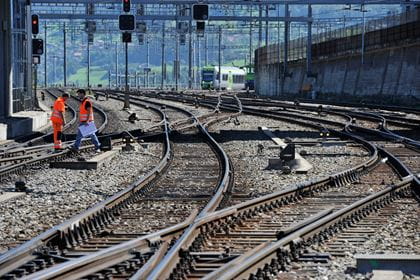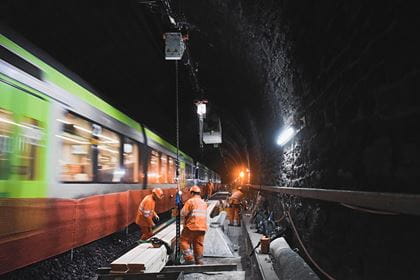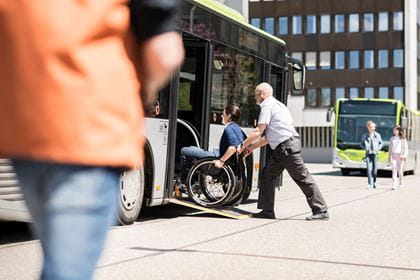Expansion of our infrastructure
BLS operates a rail network spanning 420 kilometres. In over 500 small and major projects, we maintain, renew and expand this network in order to provide better public transport connections.
BLS continuously renews and expands its rail network. To this end, over 500 small and major projects are being worked on, whether as theoretical concepts, preliminary projects or as a current construction project. The aim of any expansion work is always to create greater rail transport capacity so that passengers arrive faster and more punctually at their destination, as well as to provide greater convenience to those travelling. The planning behind such projects is always conducted in close coordination with the Federal Government and cantons.
Who is involved in deciding on expansion projects?
The proper running of the rail transport system requires that three key areas interact seamlessly: the public transport routes being offered, the rail infrastructure and the rolling stock.
The cantons and the Federal Government decide which train connections should be offered. The route planners working for the rail operators transform the ordered service into a specific public transport offering. Those in charge of the infrastructure must then ensure that the necessary rail capacity is available so that the increased traffic can be absorbed. In addition, all trains must fit within the national and international timetable. Additional trains also require more space on the track. To this end, single-track stretches must be expanded to two or more tracks, for example. An improved service often also requires new and longer trains. This rolling stock needs to be ordered. If the trains become longer, then the infrastructure at the train stations in turn needs adapting because, for example, the platforms are too short.
The planning process is therefore highly complex: the three areas mutually influence one another and have different planning horizons as well as different forms of financing, each of which need to be coordinated with the cantons and the Federal Government. The Federal Government decides on rail infrastructure expansion projects, as it also finances these. BLS here seeks to bring the planning specifications in line with the needs of customers and those directly affected as much as possible. The expansion work should be carried out with the greatest possible cost-efficiency.
The most relevant expansion projects for the BLS infrastructure
The service offered by Bern S-Bahn is to be improved. This is the decision made by the canton of Bern as part of the so-called Second Partial Addition. To this end, trains are to operate every quarter-hour within the core perimeter surrounding Bern, and every half-hour on the rest of the network. The trains are also to be extended in length. Along with Bern S-Bahn, we are also expanding the services of our other S-Bahn networks, such as Lucerne S-Bahn and RER Fribourg. These changes will require extensive expansion work. In the following places, an expansion of the BLS infrastructure is in the concept study stage, the planning stage, the implementation stage or has already recently been completed.
Bern–Neuchâtel section:
- Train station modernisation and adaptation of the platform height and length in Gümmenen and Müntschemier
- Dual-track expansion of the Rosshäusern-Mauss line, including new Rosshäusern Tunnel
- Dual-track expansion of the Mauss–Gümmenen line, including Saane Viaduct
- Platform extension in Bern Stöckacker, Gampelen and St-Blaise-Lac
- Third track (turnaround track) in Bern Brünnen
- Fifth track in Ins
- Dual-track expansion of the Müntschemier–Ins line
- Dual-track expansion of the Zihlbrücke–Marin-Epagnier line
Bern–Belp–Thun section:
- Dual-track expansion of the Wabern–Kehrsatz Nord line, including platform extension at Kehrsatz Nord Railway Station and modernisation of Wabern Railway Station
- Platform extension at Belp Steinbach, Toffen and Kaufdorf
- Modernisation of Thurnen Railway Station
Bern–Schwarzenburg section:
- Adaptation of tracks for turnaround option in Niederscherli
- Adaptation of the platform in Gasel
- Dual-track expansion of the Liebefeld–Köniz line
Solothurn–Burgdorf–Ramsei (–Sumiswald-Grünen)–Langnau section:
- Train station modernisation and adaptation of the platform height and length in Kirchberg-Alchenlfüh, Wiler, Gerlafingen, Biberist Ost, Burgdorf Steinhof, Ramsei, Grünenmatt and Sumiswald-Grünen
Hasle-Rüegsau–Thun section:
- Train station modernisation and adaptation of the platform heights and lengths in Biglen, Grosshöchstetten, Oberdiessbach, Brenzikofen, Heimberg and Steffisburg
- Straightening of various bends
Spiez–Zweisimmen section:
- Train station modernisation and adaptation of the platform heights and lengths
- Longer crossings along the entire section
Langenthal–Huttwil–Wolhusen section:
- Train station modernisation and adaptation of the platform heights and lengths
Solothurn–Moutier section:
- Train station modernisation and adaptation of the platform heights and lengths
The development of Bern Railway Station and its accessways is also of great importance to the expansion of Bern S-Bahn. Among other things, the public facilities at Bern Railway Station are being expanded with a new walkway, and four large flying junctions will be constructed in Holligen, Wylerfeld, Wankdorf Süd and Gümligen in the coming years. The tracks will be relayed across two levels using ramps and tunnels, so that the trains have to cross the tracks of other trains less frequently. These projects will be carried out by SBB.
Additional infrastructure expansion projects on the BLS network
- In order to enable a half-hourly service on the cross-country route between Bern and Brig and to create additional capacity for freight transport, BLS is planning to further expand the Lötschberg Base Tunnel. Only 14 kilometres of its just under 35-kilometre length currently feature dual tracks.
- On the Basel–Bern–Interlaken Ost cross-country route, not all 400-metre-long trains can operate yet. In order to better connect Interlaken and the eastern Bernese Oberland to long-distance routes, BLS is planning a longer crossing in Leissingen.



